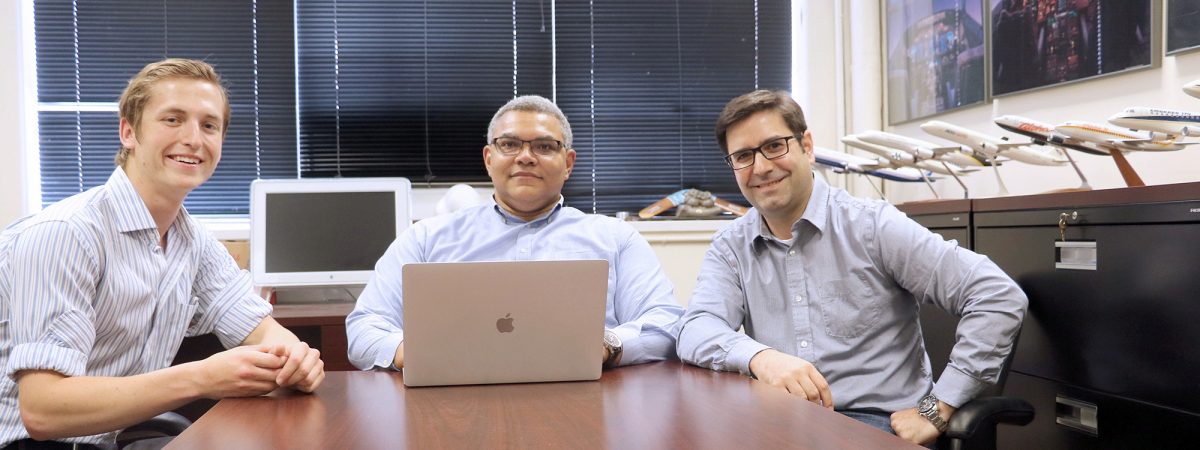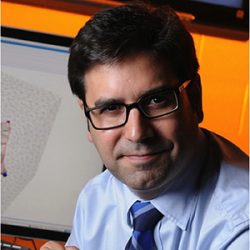 |
| Getting Ready to Explore Mars. Prof. John-Paul Clarke, center, and his co-PI, Prof. Julian Rimoli, right, are seen here with James Gloyd, an undergrad who will continue in his graduate studies working with the two faculty on the Evacuated Airship for Mars Missions. |
A gas-free space vehicle designed by AE professor John-Paul Clarke and his research team is one of 22 early-stage technology proposals recently selected for a first round of funding by the 2017 NASA Innovative Advanced Concepts (NIAC) program.
 |
| AE Prof. John-Paul Clarke |
Clarke and co-PI Prof. Julian Rimoli will receive $103,000 to explore the capabilities and feasibilities of their Evacuated Airship for Mars Missions project over a nine-month period, beginning sometime this summer. They will be joined by James Gloyd, an AE undergrad who has been investigating the use of a vacuum instead of gas to provide lift in a space vehicle. Gloyd will continue that work as a graduate student in Clarke's lab.
As a Phase I NIAC proposal, the Evacuated Airship will then be eligible to compete for Phase II funding, worth as much as $500,000. Ultimately, NIAC-supported projects will be considered by NASA for inclusion in a Mars or other deep-space missions.
Clarke is optimistic about contributing to those missions; the Evacuated Airship concept is uniquely designed to handle the challenging material and atmospheric issues of deep space travel.
“NASA didn’t want incremental projects or minor improvement on an existing concept. They wanted ideas that
would change the way space travel will take place. And that’s what we’re doing,” he said.
Clarke’s team has designed a vacuum-based airship – buoyant and light like a standard balloon but different in some critical aspects. Whereas a balloon uses helium or hydrogen to displace air and provide lift, a vacuum airship uses a rigid structure to maintain a vacuum that displaces air and provides lift.
 |
| AE Prof. Julian J. Rimoli |
“The key is the materials – new materials and engineering – that allow us to handle deep space environments. They are strong enough to resist the vacuum -- so the vehicle doesn’t implode – but light enough to be buoyant.”
Clarke said the team is considering reinforcing the walls of this rigid balloon with a specially constructed skeleton, most likely a tensegrity structure such as those that have been developed by Rimoli (link).
“A multi-layer approach, in conjunction with a lattice, would circumvent the buckling problems of a single homogenous shell. The lattice used to support the two layers of the vacuum airship shell can be made to fit the curvature of the vacuum airship precisely by following an atlas approach to the modulation,” he said. “But that is just one idea. We will try many.”
The 2017 NASA Innovative Advanced Concepts (NIAC) portfolio of Phase I concepts cover a wide range of innovations, each selected for their potential to revolutionize future space exploration.
"The Phase I competition has resulted in an excellent set of studies," said Jason Derleth, NIAC program executive. "We look forward to seeing how each new study will expand how we explore the universe."
As his team firms up the details of the concept in the coming months, Clarke has confidence that the Evacuated Airship will receive Phase II funding and find its way into space. Among the advantages they forsee:
-
The Evacuated Airship will be able to overcome physical obstacles– trenches, steep terrain, crevices – that have been problematic for more traditional exploration vehicles, like the Rover;
-
An Evacuated Airship will be employable as a communication relay for other vehicular probes on Mars, thereby overcoming line-of-sight constraints;.
-
If the Evacuated Airship is damaged, it will not require gas for re-inflation after being repaired. It can be re-evacuated and resume operation;
-
Since the Evacuated Airship does not use a lifting gas, it can perform a near infinite number of compensation maneuvers to adjust or stabilize its altitude in a temperature variant environment;
-
The Evacuated Airship will be able to use its structure to protect the instruments from solar radiation and high energy particles;
-
The large surface area of the Evacuated Airship will provide plenty of area for solar cells which will allow the vehicle to gather a large amount of solar energy without any additional structure;
-
Unlike helicopters and airplanes, the Evacuated Airship will not require a unique energy source to provide lift. Once the airship is evacuated, the only energy it will need is for propulsion, which can be accomplished by electric motors.